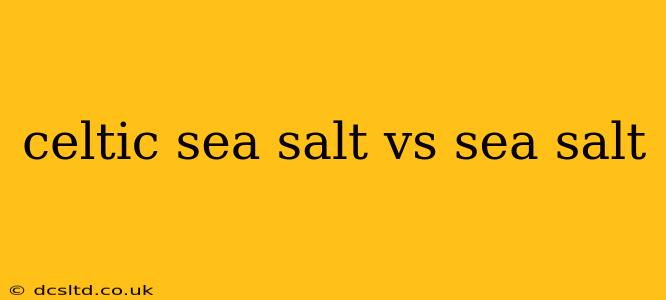Sea salt. We sprinkle it on our food, use it in cooking, and even enjoy it in spa treatments. But not all sea salt is created equal. One variety often touted for its superior qualities is Celtic sea salt. This article delves into the key differences between Celtic sea salt and regular sea salt, exploring their origins, mineral content, taste, and overall health benefits.
What is Celtic Sea Salt?
Celtic sea salt, harvested primarily from the Guerande salt marshes in France and the Noirmoutier Island, boasts a unique history and production method. Unlike many commercially produced sea salts that undergo extensive processing, Celtic sea salt is minimally processed, retaining a higher concentration of natural minerals and trace elements. The traditional harvesting methods, often involving hand-raking and sun-drying, contribute to its distinct characteristics.
What is Sea Salt (Generally)?
The term "sea salt" is quite broad. It encompasses various salts harvested from different oceans and seas worldwide. The production methods vary significantly, ranging from simple evaporation in shallow pools to more industrialized processes involving refining and bleaching. This results in a wide range of variations in taste, texture, and mineral composition. Often, commercially processed sea salt undergoes significant refinement, removing many of the naturally occurring minerals.
How Do They Differ in Mineral Content?
This is where a crucial distinction lies. Celtic sea salt, due to its minimal processing, generally contains a broader spectrum of minerals and trace elements than many commercially produced sea salts. These minerals, including magnesium, potassium, calcium, and iron, contribute to its slightly different flavor profile and potential health benefits. While the exact mineral content can vary depending on the source and specific harvesting conditions, Celtic sea salt typically boasts a richer mineral profile.
What About Taste and Texture?
Many people describe Celtic sea salt as having a slightly less salty, more complex flavor compared to refined sea salt. This is largely due to the presence of those additional minerals. It often possesses a slightly gray or pinkish hue and a coarser texture compared to the fine, white crystals of refined sea salt. The texture also lends itself to different culinary applications; some prefer it for finishing dishes, while others incorporate it into cooking.
Is Celtic Sea Salt Healthier?
The claim that Celtic sea salt is "healthier" is often debated. While it contains a wider range of minerals, the amounts are generally not significantly higher than those found in a balanced diet. The benefits often cited relate to the potential positive effects of these trace minerals on overall health. However, it's important to note that more rigorous scientific research is needed to definitively establish specific health advantages over regular sea salt. Moderation in salt intake remains crucial for maintaining good health, regardless of the type of salt consumed.
Does Celtic Sea Salt Contain Less Sodium?
No, Celtic sea salt does not inherently contain less sodium. The sodium content is comparable to other sea salts. The difference lies in the presence of other minerals which might subtly alter the perceived saltiness and potentially how the body processes the sodium.
Which One is Right for Me?
The choice between Celtic sea salt and regular sea salt largely depends on personal preference. If you appreciate a more nuanced flavor profile and prefer minimally processed foods, Celtic sea salt might be appealing. If you prefer a more readily available, less expensive option, then regular sea salt will suffice.
Is there a difference in the iodine content?
The iodine content can vary greatly depending on the source and processing of both Celtic Sea Salt and other sea salts. Some sea salts are iodized, meaning iodine has been added, while others are not. It's important to check the label to determine the iodine content. Neither Celtic Sea Salt nor other sea salts are guaranteed to have a significantly higher or lower iodine content compared to each other without checking the specific product's label.
In conclusion, while both Celtic sea salt and regular sea salt originate from the sea, their production methods and resulting mineral content differ. The choice ultimately comes down to personal taste and dietary preferences. Remember, moderation in salt intake remains key to maintaining a healthy lifestyle.
